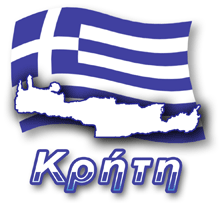
Leaving Heraklion and following route number 97 leading south of Crete you will get to several of the most important places of the ancient world of this island. After the road changes direction and begins to lead west, along its axis are the ruins of the palace in Phaistos , the mysterious villa in Agia Triada and the remains of Gortyna. If only you have enough perseverance and time, then you can plan a trip in these three places one day, although it is better to set them apart in time. Watch one by one, they blend in your memory, and the sun, which can not be avoided in any of these places, will drink all of you water.
Gortyna / Gortys / Gortyn (Greek: Γόρτυνα, Γόρτυς) is considered one of the most extensive excavations in Greece. You'll find a kilometer after you cross the small village of Agia Deka for the ruins of a city with an uninterrupted history of 6,000 years. Contemporary asphalt cuts almost half of the former metropolis.
On one side of the road behind the fence you will find the remains of the church of St. Titus, a small odeon and unusual tables with the Gorton law. On the other side of the olive trees are the recently fenced, extensive remains of the basilica, the temple of Apollo and the Egyptian gods, the Praetorium and the Roman baths.
The admission is paid to the first part, and not yet to the second one. Paradoxically, this is the second part that requires much more time to get around the remains of the former capital of Crete and Cyrenaica.
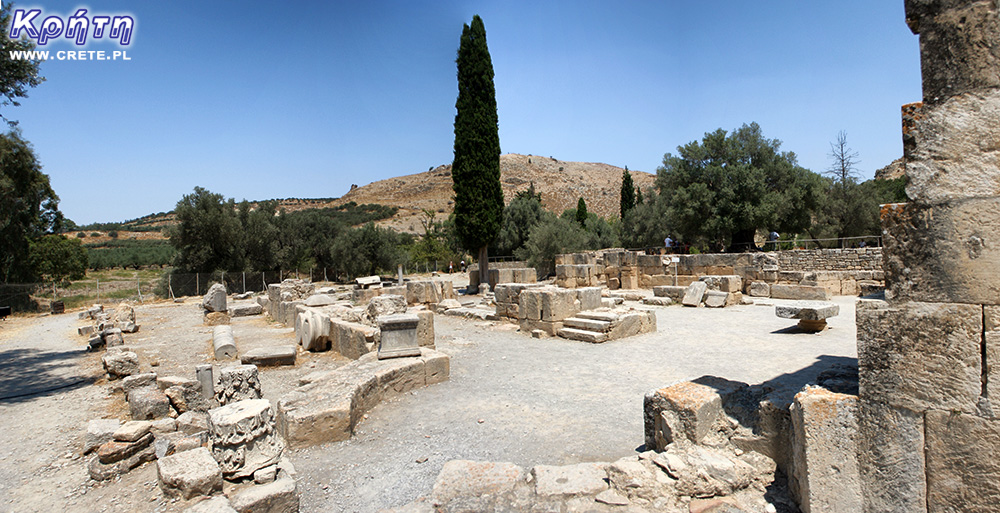
The first part is more orderly, enveloped and adapted to tourist traffic. However, the strength of the second part is the lack of order. Only the fence reminds us that, however, we are only temporary guests, tourists visiting this place. Scattered chaotically among olive trees remains of old culture, fragments of broken clay pots, sometimes create a rug, after which you can not tread. Standing here and there, fractions of columns and remains of paved roads remind us that once the inhabitants of this city were walking on the same stones, and their skin was smothered by the same sun. In places where the discovered ruins have not been renovated or reconstructed, it is best to hear " centuries that speak ".
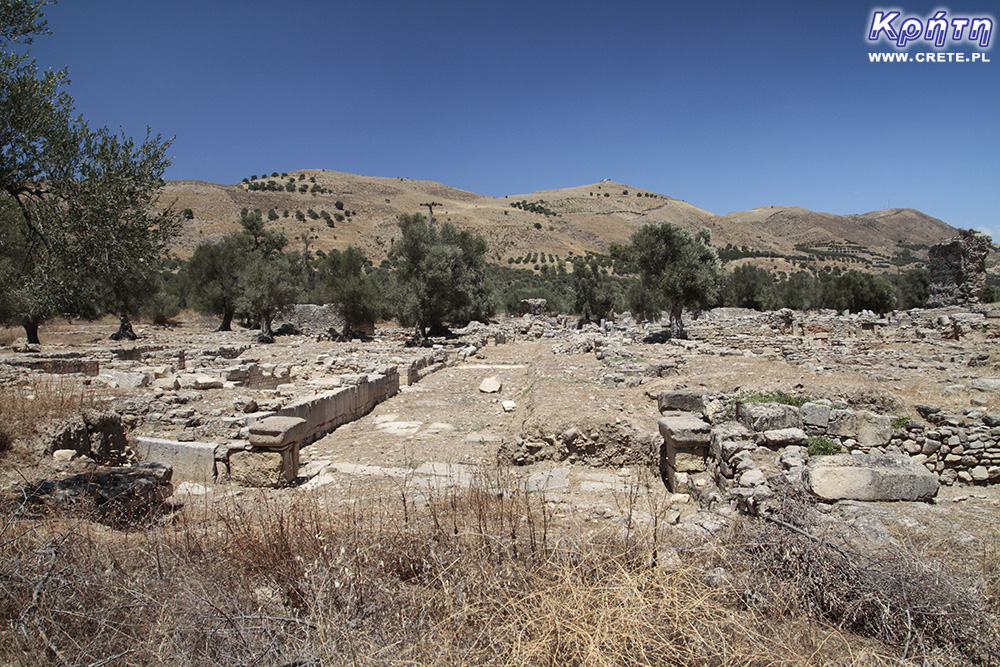
Gortyna takes time. Both parts of it are worth seeing, touching, going around. You must be aware, however, that what is shared with our eyes is still only a small part of the treasures that this part of Crete conceals. Some of the buildings unveiled by archaeologists are unavailable to visitors. It is worth mentioning the great amphitheater located on the hill. Unfortunately, you have to leave it for other arrivals and come back here in a while.
Gortyna is still "live" excavations that still arouse great interest of archaeologists. Every year of their work in this red earth, it allows to find amazing fragments of old reality, such as the rare silver coin issued in Knossos. On one side of it there is an image of the famous Minotaur, and on the other side a mythical Labyrinth.
The name Gortys was taken by the name of its founder, a certain Gortys. However, there is no consensus as to where it came from, or even whether it was a man.
In the area where Gortyn was founded, people lived from the end of the Neolithic period. After the Minoan era, remains were found in the form of residential villas near the village of Mitropolis, and after Doras, temples dedicated to Apollo and Athena from the 7th century BC. However, the proper history of this place began to take place when in the third century BC Gortyna defeated in the local Fajstos war and took power in the whole region of Messara.
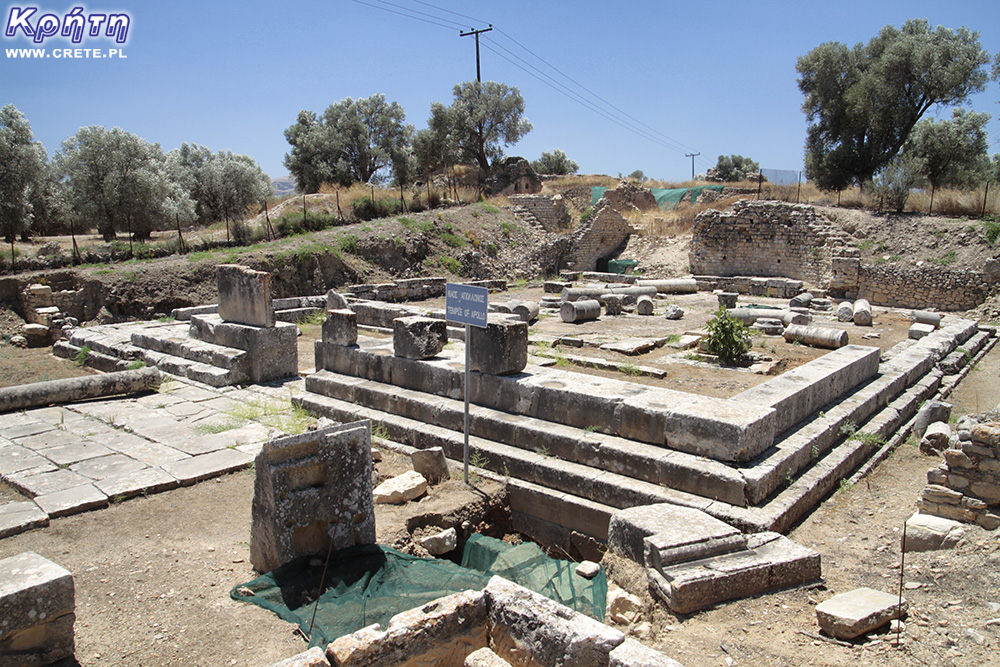
Remains of the Temple of Apollo
In 67 BC, the Romans became interested in Kreta. Gortyna, who strongly supported the invaders, was later rewarded for that. The Romans established here the capital of Crete and the Roman province of Cyrenaica embracingEgypt and part of North Africa. Thus they took away the current meaning of Knossos, which was a Roman enemy.
The impressive remains of Gortyna only confirm its high status at that time and important political and economic significance. As the story of the ruler Gortyna showed in this game for a good horse, because her role as the capital of Gortyna until the Arab conquest of Crete, which occurred almost 9 centuries later in 824 AD
In 330, the city was conquered by the Byzantine Empire. It is here that the apostle Titus, the first bishop of Crete and her patron, proclaimed Christianity, and Gortyna became the first city of Crete to support the new faith. It is to him that two temples have been dedicated, the ruins of which can be seen.
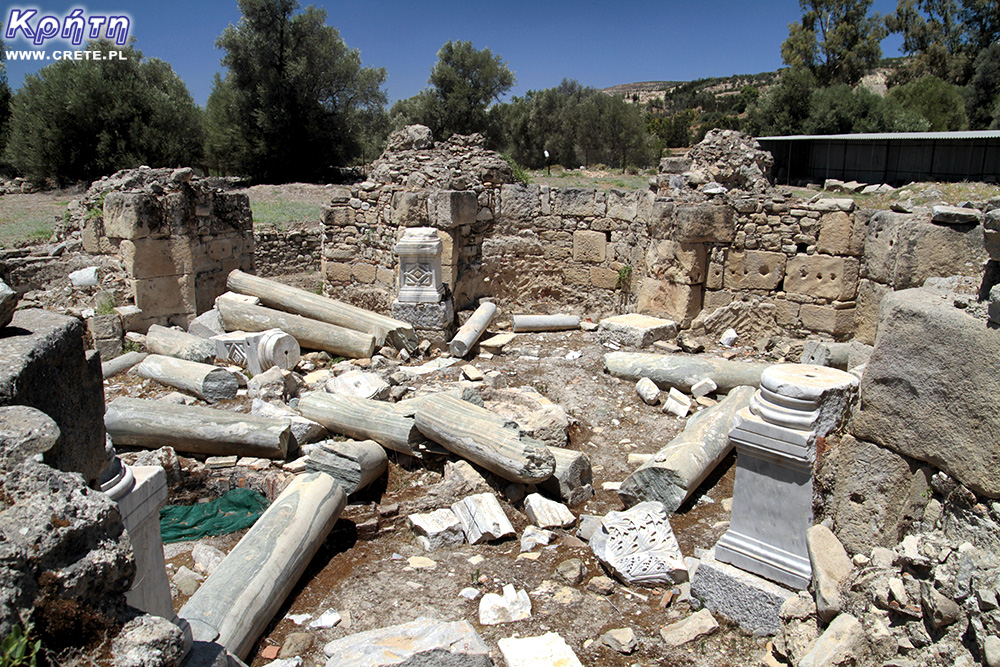
Remains of the Basilica of Saint. Titus
The beginning of the city's peak years was from the 2nd century AD to the 7th century AD. Gortys grew and became one of the most important cities in Crete. At that time, its population was the most numerous on the island.
The beginning of the end of this power occurred in 796 when the city was destroyed almost completely during the earthquake. 32 years later Saraceni finally sealed her fate and sentenced to oblivion by transferring the capital of Crete to Candia (al-Khandaq), or modern Heraklion.
Scientists became interested in Gortyna's area at the end of the 19th century, when Crete was still under Turkish occupation, and Knossos, buried underground, waited patiently for his discoverer. In 1857, at a local mill, two French travelers, G. Perrot and L. Thenon, discovered a small piece of a plaque embedded in the wall of a watermill in the neighboring village of Agioi Deka, on which there were 15 lines of archaic text.
The find was purchased for the Louvre museum, where an unknown letter aroused the interest of researchers who made attempts to read it. This has already been done around 1878. As it turned out, the deciphered fragmentary record concerned the rules of adopting children. A year later, another French scientist B. Haussoullier, in the walls of a house in the same village, found another stone. The text consisting of 15 poems on it was the initial fragment of the code, as it later turned out, of inheritance law.
At the end of 1884, the Italian archaeologist Federico Halbherr, one of the foremost explorers of ancient buildings in Crete, such as the Palace of Phaistos or the villa of Agia Triada, went to Agioa Deka. He wanted to look at the mill in which these mysterious recorded discs were discovered. Happiness favored this expedition, and Halbherr was writing another discovery. The stream flowing into the mill changed its course. The water left the existing trough and began to flow a short distance below the mill. A wall formerly below the water level appeared to the scientists' eyes. Their special attention was drawn by a few signs visible in its upper part. Halbherr made a pit along the wall and discovered four extremely precise columns.
Halbherr was not able to complete the excavations himself due to the lack of legal capacity to conduct them. A few months later, after obtaining the consent of the owners of the site to continue the work, eight more columns were discovered with the ancient law written, later called the Code of Gortyna. This was accomplished by Halbherr, a German archeologist Ernst Fabricius. At that time the Great Inscription, as the Codex of Gortyn was called, was considered the most important archaeological discovery of the century.
The stone columns forming the semicircular wall could once have been part of the bouleuterion or other public building with a diameter of 30 meters. Twelve columns with the Code are 10 m wide and 1.5 m high. Together, they contain 605 preserved lines of text engraved by one sculptor in the first half of the 5th century BC
The discovery of the Great Inscription led to the commencement of excavation work in this area. They were conducted by the Italian Archaeological Mission in cooperation with the Archaeological Service after, in 1898, Crete regained its autonomy. The work was led by Federico Halbherr, Joseph Hatzidakis and Stefanos Xanthoudides. Today the most important finds are presented in the Archaeological Museum in Heraklion.
Currently, the ruins of ancient Gortyna occupy an area of about 400 hectares. This 2-meter quadrangular area is the largest in Crete and one of the largest in all of Greeceji archaeological site. These sizes should not come as a surprise, as the city in Roman times had to accommodate 35-40,000 inhabitants and 5000 mercenaries.
On its premises, apart from public buildings and temples, fountains, colonnades, workshops, schools, aqueducts and waterworks, baths, theaters, markets and junior high schools were created.
The stone for its construction was taken from a nearby quarry called the Messara labyrinth located near the town of Ambelouzos.
Water collected from springs on the Psiloritis slopes was brought to Gortyna by aqueducts. On its territory, water supply systems were distributed to 46 fonntans, a bathhouse and laundry. A large number of residents required efficient management and ordering of legal issues. Discovered boards with the Gorton code also prove that Gortys was one of the best-managed cities in Crete.
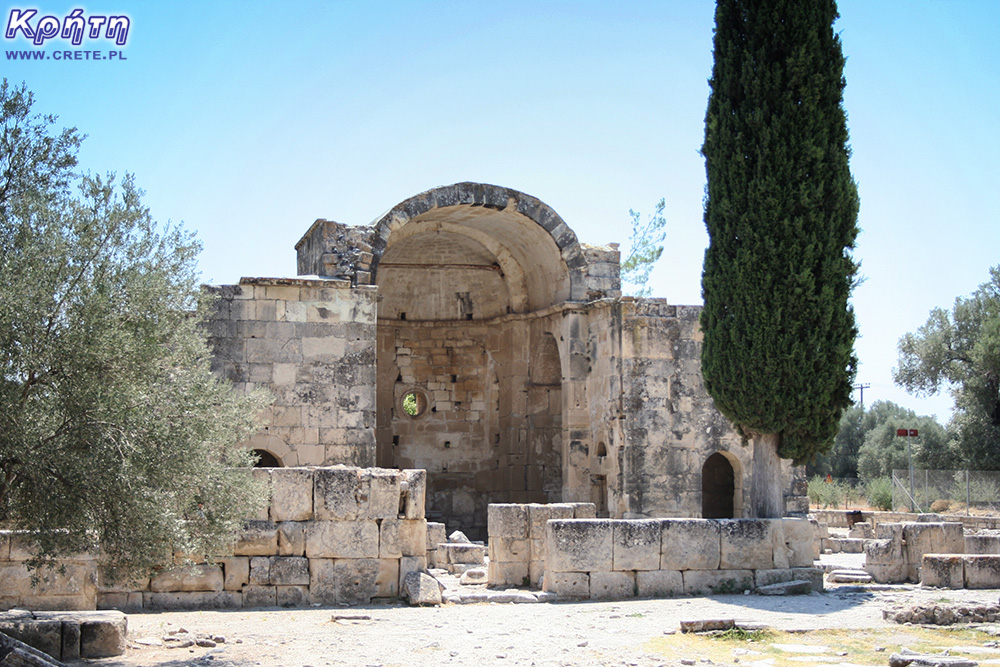
Inside the main northern archaeological site is the most impressive and characteristic building. It is a fragment of the basilica dedicated to Saint Titus, the first bishop of Crete. This building was created between the 6th and 7th centuries after the destruction of the original basilica, the fragments of which are located on the other side of the asphalt road. Around this building, stone sarcophagi were also found that were used during the burials of priests. The basilica was destroyed by the Arabs in 824.
Odeon in Gortyn was the largest building of this type in ancient Crete. It's a kind of theater but with a roof that has improved the acoustics. In ancient metropolises it was an important part of the city, because there were theater and music performances and meetings. Three rows of benches have been preserved in the Gorton Odeon.
At the back of the Odeon is the most important find, from which the modern history of Gortyna began, that is, the tables with the code found by Halbherr. It is worth taking a closer look at these carefully written lines of text in stone. Equal rows of letters were carved in the 5th century BC with a style called bustrofedon, which can be described as " how do oxen oxen ". This means that the oldest preserved law of ancient Greece was read alternately, ie the first line of the text from right to left, the next from left to right, etc.
The provisions included in the code were governed by family law, property and property inheritance, also when the heir was a woman.
A few minutes away from the car park you can see some of the sculptures found in Gortyna. The memory of the emperor Antoninus Pius is especially remembered for a long time in memory.
At the back of the Odeon's buildings and the boards of the Gorton, it is worth to look at the characteristic evergreen plane tree. As it turns out, this tree has its place in Greek mythology. According to her, it was here that Zeus, together with the kidnapped Europe, were to beget three sons: Minos, Rhadamanthys and Sarpedon. Apparently, since then, the plane has not lost its foliage. Something must be in this story, because it was here that several coins were found, on which Europe and Minos are depicted (other sources indicate that it is Zeus).
The cult of this tree has survived to modern times, and some people collect its leaves. It is believed that this tree has the magical ability to help women give birth to boys. This is of course related to the mythological Europe that gave birth to three sons, later kings of Minoan Crete.
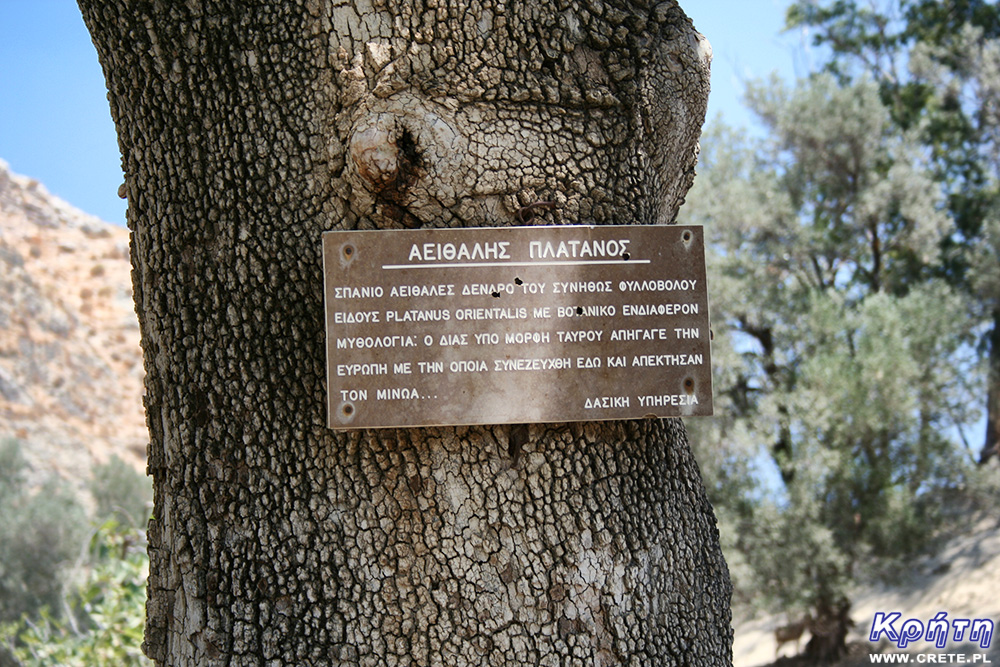
On the top of the hill located in the immediate vicinity of the city there are ruins of the Gortyna acropolis. Archaeologists have found here the ruins of a Byzantine basilica from the 6th century AD, which was built on the site of an older Greek temple dedicated to Athena from the 7th century BC
On the other side of the asphalt road there is a larger part of the excavations. To view it you do not need a ticket (at least for now). The remains of the buildings located here give an idea of the size and power of Gortyna.
A praetorium from the 1st century AD is a big luxuryOwls and an impressive building, used as the seat of consul of Crete and the Roman province of Cyrenaica. The praetorium was divided into two parts: administrative and private. In its area you can still see marble floors, remains of columns and monuments. In the past, there were Roman baths, a courtyard with columns, a temple of Augustus, a court and other public buildings.
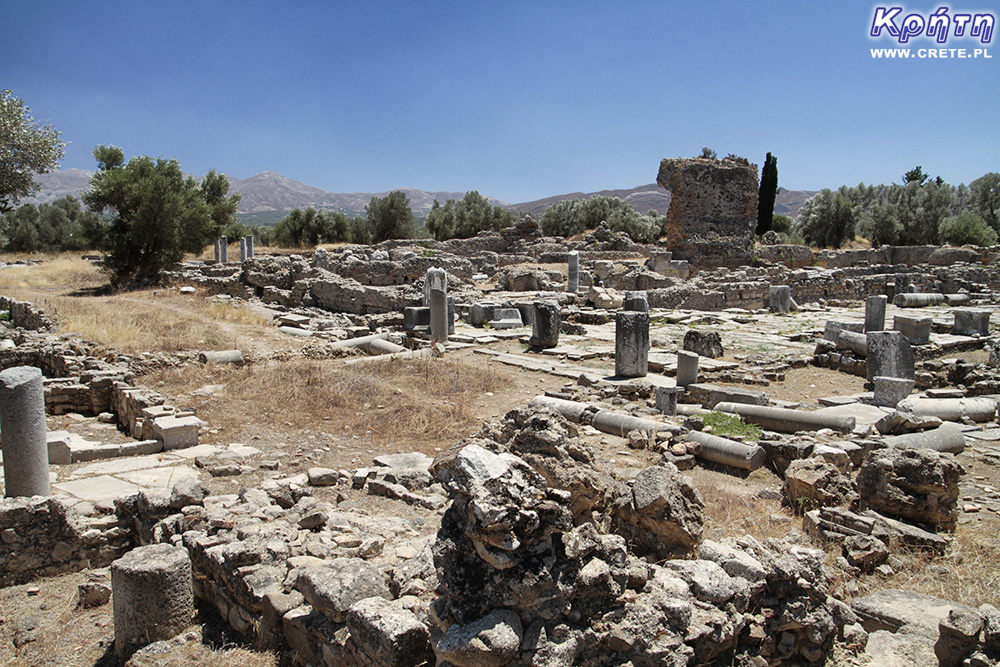
Where the Romans appeared, bathhouses were always built. It was no different in Gortyna, where a large termal complex with toilets was created. These baths were luxuriously equipped. Currently, they are not yet fully excavated.

About 200 meters south of the main archaeological site, on the road to the village of Mitropolis, there are ruins of the Great Basilica of St. Titus from the 6th century AD At that time it was the largest church in Crete. This temple was destroyed in 670 AD during the earthquake. After the disaster, the temple dedicated to the first bishop of Crete was rebuilt in the northern part of Gortyna.
On the road leading to the Praetorium, there are the ruins of the great Apollo temple discovered in 1887. It dates back to the 7th century BC and before the emergence of Christianity on Crete it was the largest temple located in Gortyna. In its vicinity there was a small theater, waterworks and single houses.
Near the Temple of Apollo there are ruins of the only ancient temple of Crete dedicated to Egyptian deities. The temple was equipped with its own water tank and had underground crypts.
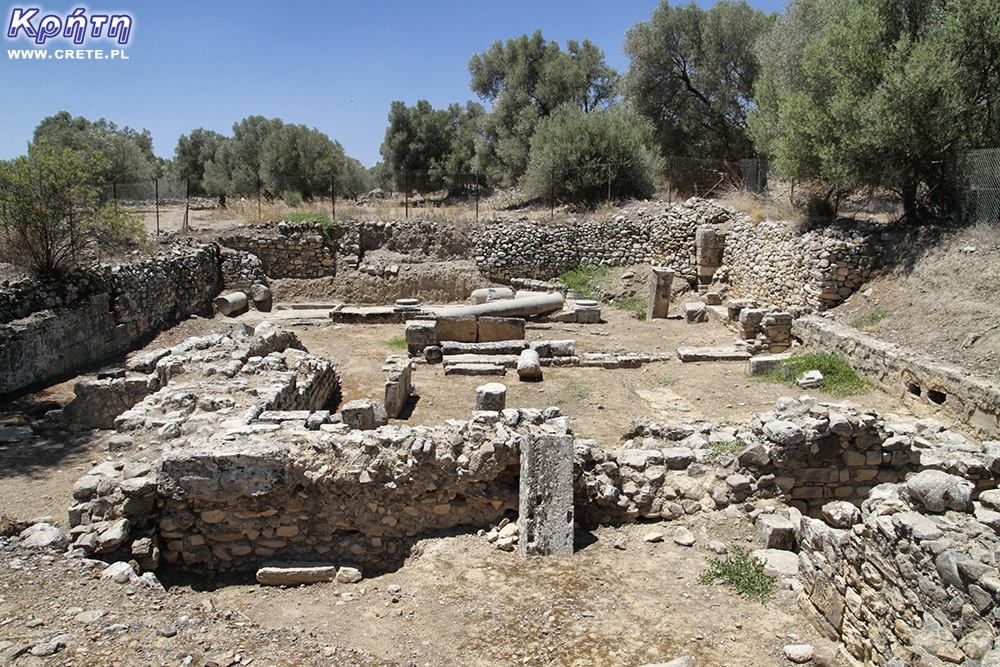
The ruins of the metropolis are not the only reminder of centuries that have passed. Equally old is the monumental olive grove in the southern part of the archaeological site. Wandering between the scattered fragments of old buildings and fallen columns, it is impossible not to pay attention to the centuries-old trees in which the old Gortys literally grew. Each of these trees is a unique work of nature with a spectacular shape and size. The age of some dates back to sixteen centuries. One of the trees you will probably remember especially because a Roman column is in its trunk. It has been recognized as a natural monument.
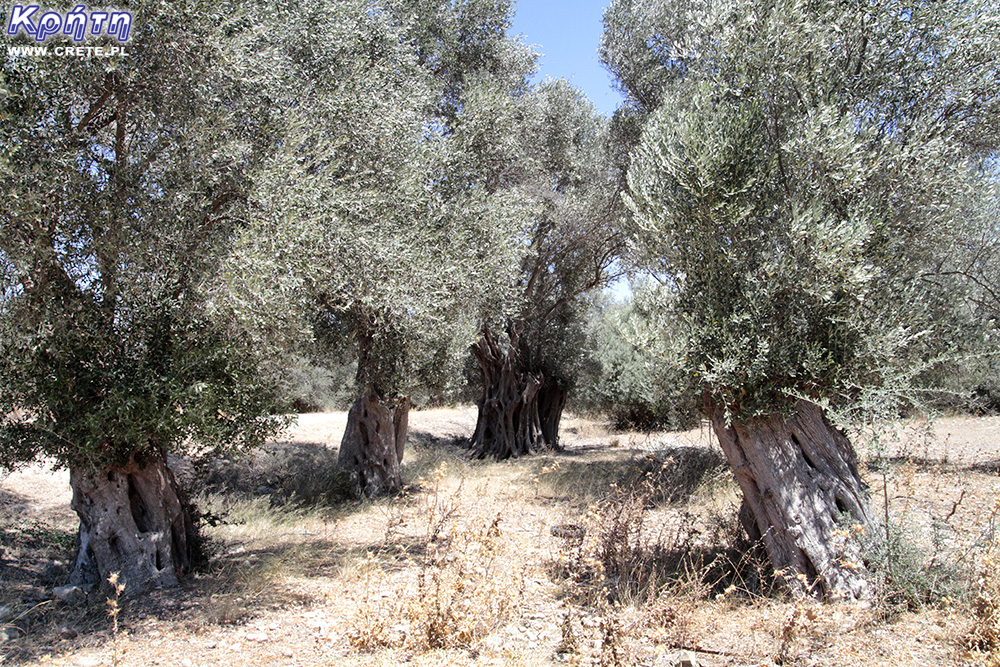
You can enter the Gortyna area throughout the whole year except for holidays. During the tourist season, the opening times are extended during the summer. The ruins of the city can be visited between 8.00 and 20.00. In the winter months, Gortyna closes at 3:00 PM
Entrance to the excavation site costs 6 € (normal ticket) and 3 € (concessionary ticket).
There is a car park at the official part. When choosing a tour of the old metropolis, it is worth taking a hat and a bottle of water with you.
↤ click the appropriate part of the island to change the bottom map
Knossos is one of the flagship monuments visited by tourists, it is also the most popular place where organized trips go.
Heraklion (Iraklion) is the largest city of Crete. With almost 140,000 inhabitants, it is the fourth largest city in Greece.
Dozens of craft workshops located in this small mountain village make Margarites one of the four main centers where traditional Cretan ceramics are made.
International airport. Nikos Kazantzakis in Heraklion is currently the largest airport in Crete.
Heraklion (Iraklion) is the largest city of Crete. With almost 140,000 inhabitants, it is the fourth largest Greek city.
The date of the foundation of Moni Arkadiou (Arkadi) is not exactly known. According to tradition, the name of this church refers to the name of the Emperor Arkadiusz, who supposedly was to be its founder.
The date of the foundation of Moni Arkadiou (Arkadi) is not exactly known. According to tradition, the name of this church refers to the name of the Emperor Arkadiusz, who supposedly was to be its founder.
Rethymnon with around 40,000 inhabitants are the third largest city of Crete. This place was populated already in the Minoan period. Historically, the city was an important commercial center.
Thrapsano is a small town inhabited by slightly over 2,500 people, the vast majority of which until recently maintained their activity as a potter.
Skinaria is a small beach located along a small bay, whose outlet on both sides ends with a rocky coast. It is still a little-known place overlooked by mass tourism
Skinaria is a small beach located along a small bay, whose outlet on both sides ends with a rocky coast. It is still a little-known place overlooked by mass tourism
According to Greek mythology, Zeus hid (and perhaps even gave birth) in the Ida cave. This myth is the greatest asset of this cave, which is not as interesting and beautiful as the Dikte cave.
Tripiti is a small beach covered with a mixture of gray sand, gravel and stones. Despite the fact that the beach is unorganized and has a semi-natural appearance, one small tavern works here.
Tripiti is a small beach covered with a mixture of gray sand, gravel and stones. Despite the fact that the beach is unorganized and has a semi-natural appearance, one small tavern works here.
Tripiti is a small beach covered with a mixture of gray sand, gravel and stones. Despite the fact that the beach is unorganized and has a semi-natural appearance, one small tavern works here.
Plakias is a perfect place for people who like to spend time hiking. In the area of the town and the surrounding area, there are several hiking trails that lead to interesting beaches.
Currently, the lower monastery is still not open to the public and is not used by the monks. The buildings of the upper monastery have undergone partial renovation and are the main seat of the Preveli monastery.
Currently, the lower monastery is still not open to the public and is not used by the monks. The buildings of the upper monastery have undergone partial renovation and are the main seat of the Preveli monastery.
Currently, the lower monastery is still not open to the public and is not used by the monks. The buildings of the upper monastery have undergone partial renovation and are the main seat of the Preveli monastery.
The Kourtaliotiko Gorge, also known as the Asomatos Gorge, is perhaps one of the most spectacular natural attractions available in the central part of Crete.
Agia Triada is a small Minoan archaeological site in the south of Crete, located near Timpaki, located on the western slope of the hill about 40 meters above sea level.
Około 60 kilometrów na południowy zachód od stolicy Krety - Heraklionu znajdują się ruiny drugiego co do wielkości starożytnego pałacu - Fajstos.
Currently, Melidoni Cave (originally called Gerontospilios) is associated mainly with the tragic events that took place here in 1824.
This fortress is a perfect example of Crete's multiculturalism. Located today in Greek hands, it was built by the Venetians, but is called a name taken from the Turkish language.
It is one of the most important and largest museums in Greece and one of the most important in Europe.
Tylissos is one of the few places in Crete that has kept its name since ancient times.
Plaża w Damnoni jest położona po sąsiedzku z Plakias - popularną turystyczną miejscowością
Agios Pavlos is a small town located on the southern coast of Crete near Saktouria.
Triopetra is located at the foot of the Siderotas mountain about 52 km south of Rethymno.
gia Galini (Αγία Γαλήνη) jest jednym z najpopularniejszych nadmorskich kurortów na południowym wybrzeżu Krety.
The observatory is located at the top of the Skinakas mountain at an altitude of 1750 m. The idea for its construction was born in 1984.
The Late-Romanesque cemetery in Armeni is located on the outskirts of this town, located less than 10 km south of the center of Rethymno.
The museum presents the dramatic history of Crete written over the last several hundred years.
The modern settlement known as Argyroupolis was built on the site of the ancient city of Lappa (also called Lambi)
Lentas is a good idea for those who want to get away from villages steeped in industrial tourism.
This ancient quarry, consisting of two parts by modern times, is called Λαβυρινθάκι and Λαβύρινθος.
If anyone of you is looking for a good restaurant near Matala and Kalamaki, then we would like to recommend estiório Chrisopigi.
Psiloritis (Timios Stavros - Holy Cross) is the top of the highest mountain of Crete, rising to 2456 m above sea level.
Rouvas Gorge is one of the most interesting places in this part of Crete. The interesting trail leads in a perfect way to the changing appearance of this gorge.
Matala is one of the most popular towns not only of the southern coast but also of the whole of Crete. In the 1960s and 1970s, this small fishing village was a mecca for hippies.
The Odigitrias Monastery is one of the most famous monasteries of southern Crete. Unfortunately, in terms of popularity, he is far from other Cretan monasteries.
Kali Limenes (meaning Dobre Porty or Piękny Przystanie) is a coastal town located in the Asterousia Mountains on the southern coast of Crete.
In addition to the famous grand palaces on the island in the Minoan period, a number of smaller residences were created. One of the most important examples is the Vathipetro discovered about 5 km north of Archanes, on the southeastern slope of Mount Juchtas in the central part of Crete.
When traveling around Crete, it is not difficult to pay attention to the fact that most of the beaches there are relatively small and short. For this reason, people who are used to our national Baltic standards, where the sandy coast stretches for kilometers, may experience a special disappointment. However, fortunately, nothing is lost, because Crete in its rich arsenal of various beaches can boast of those that allow for long walks along the coast. One of them, our favorite is the Kommos beach located in the south of the central part of the island.
Although there are countless caves in Crete, only a few can be visited. Sfendoni is the largest cave open to the public. content comes from: http://www.crete.pl www.CRETE.pl
The old Venetian port and the lighthouse are one of the most recognizable elements of Rethymno.

At present, the beginnings of settlement in this place date back to 1200 BC. Later, after 630 BC Azoria developed into a small town, whose population is estimated at between 2 and 5 thousand people.
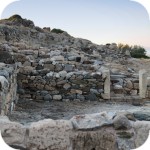
When, in 1960, heavy building equipment entered the small headland of Trypitos next to Sitia, no-one expected the land to hide the ruins of the ancient Hellenic city. To this day, this area is still being examined by archaeologists, and the found treasures feed the resources of the Archaeological Museum in Sitia. These niche excavations located just off the road to Vai are a must stop for any archeology enthusiast.
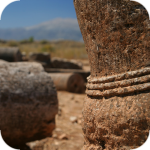
The name Aptera means no more or less without wings and is a direct reference to the legendary musical duel for which the Muses were challenged by Sirens, who were half-women and half-birds at the time. They did not have anyone in their territory who would be a worthy opponent in their singing and music. However, the duel with the Muses lost, and crushed by the result of the competition, they threw their wings and feathers to Soudha Bay. According to legends, today we can admire them as islands located at the mouth of the bay.
Komentarze
komentarz z
Lubię krete ale te parę kamieni to żadna atrakcja. Grecy odkryją parę resztek z dawnych murów i sprzedają jako super sensacyjne odkrycie.
Wypełnij poniższy formularz aby dodać komentarz
lub kliknij w poniższy link aby skorzystać z możliwosci komentowania przez facebooka:
https://www.facebook.com/crete.poland/posts/10154809613362551